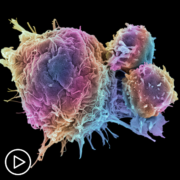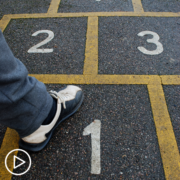How Has CAR T-Cell Therapy Transformed Myeloma Care?
How Has CAR T-Cell Therapy Transformed Myeloma Care? from Patient Empowerment Network on Vimeo.
How has the emergence of CAR T-cell therapy impacted myeloma care? Expert Dr. Shambavi Richard explains which myeloma patient groups could benefit from CAR T-cell therapy and shares research updates from recent clinical studies.
Dr. Shambavi Richard is Co-Lead Physician for the Myeloma CAR-T Programs at Mount Sinai Tisch Cancer Center. Learn more about Dr. Richard.
See More from The Care Partner Toolkit: CAR T-Cell Therapy
Related Resources:

|

|

|
Transcript:
Katherine:
Dr. Richard, how is CAR T-cell therapy impacting the landscape of myeloma care?
Dr. Richard:
So, as I’d hinted or alluded to previously, prior to CAR T cells appearing on the horizon, we had very limited options for patients who had had the first several lines of therapy.
So, once they had been exposed to two proteasome inhibitors, two iMiDs, and then anti-CD38 antibody which is the three major class of myeloma drugs, they are then called triple class exposed or penta-exposed depending on how many of these drugs they’ve been exposed to.
We had a study called the MAMMOTH study back – this was published back in 2019 prior to the era of CAR T cells and other T-cell directed therapies. And at the time they had looked at patients who were triple class exposed, and who had been exposed to daratumumab were refractory to daratumumab as their last line of therapy. And what we saw was with their next line of therapy or whatever else was available at the time for patients such as these, their expected response rate was only about 30 percent or so, number one.
Two, their outlook was very poor with a median progression-free survival which means that the amount of time that patients could go without the disease coming back, and that median progression-free survival was less than six months. And their expected even median overall survival was well under a year. So, that was what the landscape looked like when CAR T cells came onto the scene. For instance, the CART2 trials, which is one of the approved products which is cilta-cel which is what we have now, we actually saw for this same group of patients, the response rate was now 98 percent.
Deep responses were 83 percent. And we now have the final readout of their median progression-free survival which is almost three years. So, you can see a significant difference.
Under six months, media progression-free survival to three years. And over 50 percent of the patients were living over three years. So, that’s kind of where we are at. I mean so it was no small improvement. This considerably kind of almost reset the bar and has given a new lease of hope and life to patients who had advance myeloma. And one of the things we say in myeloma is although we don’t, as yet, say that myeloma’s curable, we are working towards that. But we are also giving options for other treatments, other research to be effective in patients just by keeping them around longer.
Katherine:
Have there been any recent research developments involving CAR T-cell therapy that patients should know about?
Dr. Richard:
Absolutely. So, much as I have highlighted all the hope and the optimism and the good things about this, the fact is we’re still not curing people with these therapies.
So, we called this a plateau in the survival curve which means that if we achieve that plateau, that means the disease is probably not coming back, and we have essentially the definition of cured. But we’re not seeing that. We’re still seeing a downslope in the survival curves of myeloma which means that patients are still relapsing in spite of these excellent therapies.
So, there’s a lot of research going on into why are patients still relapsing? Is it because they’re losing the antigen which the CAR T cells are recognizing? Is it because the CAR T cells are no longer effective even though the antigen is still present? Is it because there’s a considerable lag time between the patients being freezed or collected, the cells being collected for the genetic modification in the lab to the time when the patients can actually receive these cells? And that can be anywhere between four to eight weeks.
So, during this time period, patients with advanced myeloma may not remain static with their disease. The disease is progressing. They’re getting worse. They may not be candidates for these kinds of therapies. So, one of the areas of research is how can we speed up this process, this manufacture process? How can we make it much more available? Because they’re limited by the manufacturing facilities, their abilities to have these viral vectors, to be able to transduce these cells and genetically modify.
So, can we take them off of those kinds of things? Can we automate this? Can we improve these manufacturing platforms? So, a lot of different things are being tested. And then as I’d also mentioned earlier, right now they’re approved for advance myeloma, but what if we can bring them up earlier? Are patients actually going to get cured by that? Are they going to have a much better progression-free survival with that versus waiting until they’re very advanced? So, these are all many, many things that are being looked at.
In addition, a lot of these CAR T products, these approved products, all them are all recognizing one antigen on the myeloma cell. Now there are products are being looked at that are dual target antigen recognition ability. So, that’s another thing. So, maybe if the CAR T cells are missing one of the antigens, and they’re not able to use that to kill the myeloma cell, maybe the other antigen can pick up the slack. So, these are various things that are being looked at.



